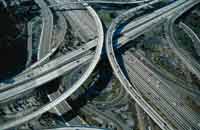[one_full]
 There are 583,000 bridges in the United States (1998). Of this total, 200,000 bridges are steel, 235,000 are conventional reinforced concrete, 108,000 bridges are constructed using prestressed concrete, and the balance is made using other materials of construction. Approximately 15 percent of the bridges are structurally deficient, primarily due to corrosion of steel and steel reinforcement. The annual direct cost of corrosion for highway bridges is estimated to be $8.3 billion, consisting of $3.8 billion to replace structurally deficient bridges over the next ten years, $2.0 billion for maintenance and cost of capital for concrete bridge decks, $2.0 billion for maintenance and cost of capital for concrete substructures (minus decks), and $0.5 billion for maintenance painting of steel bridges. Life-cycle analysis estimates indirect costs to the user due to traffic delays and lost productivity at more than ten times the direct cost of corrosion maintenance, repair, and rehabilitation.
There are 583,000 bridges in the United States (1998). Of this total, 200,000 bridges are steel, 235,000 are conventional reinforced concrete, 108,000 bridges are constructed using prestressed concrete, and the balance is made using other materials of construction. Approximately 15 percent of the bridges are structurally deficient, primarily due to corrosion of steel and steel reinforcement. The annual direct cost of corrosion for highway bridges is estimated to be $8.3 billion, consisting of $3.8 billion to replace structurally deficient bridges over the next ten years, $2.0 billion for maintenance and cost of capital for concrete bridge decks, $2.0 billion for maintenance and cost of capital for concrete substructures (minus decks), and $0.5 billion for maintenance painting of steel bridges. Life-cycle analysis estimates indirect costs to the user due to traffic delays and lost productivity at more than ten times the direct cost of corrosion maintenance, repair, and rehabilitation.
The elements of a typical bridge structure can be classified into two primary components, the substructure and the superstructure. The substructure refers to the elements of the bridge that transfer the loads from the bridge deck to the ground, such as abutments and piers. The superstructure refers to the elements of the bridge above the substructure, including the deck, floor system (beams or stringers), supporting members (beams, trusses, frames, girders, arches, or cables), and bracing. Other bridge elements, which are subject to corrosion, include guard railing and culverts. Bridge construction materials that are subject to corrosion include conventional reinforced concrete, prestressed concrete, and steel. Of these three bridge types, steel has the highest percentage of structurally deficient structures, followed by conventionally reinforced concrete and prestressed concrete. Overall, approximately 15 percent of all bridges is structurally deficient, with the primary cause being deterioration due to corrosion. The mechanism is one of chloride induced corrosion of the steel members, with the chlorides coming from deicing salts and marine exposure.
[/one_full]
